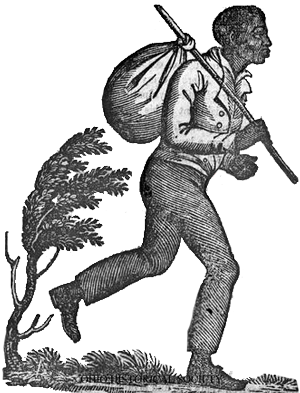On the 22nd of August in 1819, an enslaved man named Sam, who was about 36 years old, ran away from his enslaver, Daniel Morgan Boone, son of the famous trailblazer Daniel Boone. Daniel Morgan quickly advertised that a reward of $100 would be given if Sam was secured in any jail, out of the territory; or $50 if captured and returned to either of his brothers, Nathan or Jesse Boone.
Sam is described as about six feet tall, “well made” and “a little inclined to be knock-kneed” and “very forward in conversation”. He is “remarkable fond of swearing” too. He took with him a young woman named “Sile” who was enslaved by James Journey. He also managed to take a horse, a bay mare upwards of 16 hands high, who had a patch of white on her forehead, a rifle, and quite a bit of clothing. This will make him appear to be a free man to others. It is presumed that he got a pass from someone, anxious to help him reach freedom. There is no doubt that he is headed for Canada.
According to the newspaper, Daniel Morgan was living at Loutre Lick, along the Missouri River. His brother Nathan had built a large stone home, along the Femme Osage Creek further east toward St. Louis. Daniel Morgan Boone’s brother Jesse had established an inn, northwest of him, along the Boone’s Lick Trail, at Mineola Springs. The pioneer Daniel Boone had arrived in the territory in 1799, and by 1819 the trailblazer was often spending time at his daughter Jemima Boone, wife of Flanders Callaway’s home near Marthasville. His wife Rebecca Bryan had died six years earlier and was buried near Jemima’s home.

In 1812, Missouri had been organized as a territory, with St. Charles one of the five original counties. The reward had been posted in a St. Louis newspaper known as the Missouri Gazette and Public Advertiser which began in 1818 and was published by Joseph Charless (1772-1834). In 1819, a census reported that in St. Charles County 981 people were living here with 124 slaves and five free blacks. Today, that $100 reward would be the same as $2,332.88 in today’s money. The advertisement had cost Daniel Morgan $4 for placement in the newspaper for the next three months.
In 1819, residents of the Missouri Territory petitioned the U.S. Congress for statehood. Its’ residents were settlers from Virginia and Kentucky, who had brought their enslaved property with them, and wanted to continue the practice. A debate had ensued when Representative James Tallmadge proposed as a condition of Missouri’s statehood that “no further slaves could be imported into the state and all children born after Missouri’s admission to the Union shall be born free.” One can only imagine what a difference this would have made in Missouri’s history. Tallmadge’s plan did set out a plan for gradual emancipation in Missouri, that would continue to evolve and light the fuse for the Civil War. It would take the Missouri Compromise, set out by Speaker of the House Henry Clay of Kentucky, to bring the state in to the Union, as a slave state. Missouri would achieve statehood on August 10, 1821. And even after Lincoln’s Emancipation Proclamation, of January 1, 1863, it would not be until January 11, 1865, that the enslaved people of Missouri would be free.
A network to freedom, otherwise known as the Underground Railroad, developed to help those like Sam. This wasn’t an actual railroad, but a close-knit group of people who chose to help the enslaved reach freedom. Secretive, covert, undercover, this was a network of people cloaked and often disguised, that were willing to risk their own lives to help. They provided concealed, hidden, and secret hiding places, for those making their way to safety, and the ultimate achievement of freedom. German immigrants had filled Missouri’s valleys by the time of the Civil War, and having come to America in search of greater freedom’s themselves, were often willing take such necessary risks.







You must be logged in to post a comment.